
Fuel Oils Treatment for Marine Use- Refining Process
Crude oil is, at the present time, the source of most fuel oils for marine
use. Synthetic fuels are being developed but will probably be too
expensive for ship propulsion. Solid fuel, such as coal, is returning in a
small way for certain specialised trade runs. The various refined
products of crude oil seem likely to remain as the major forms of marine
fuel.




